[javascript protected email address]
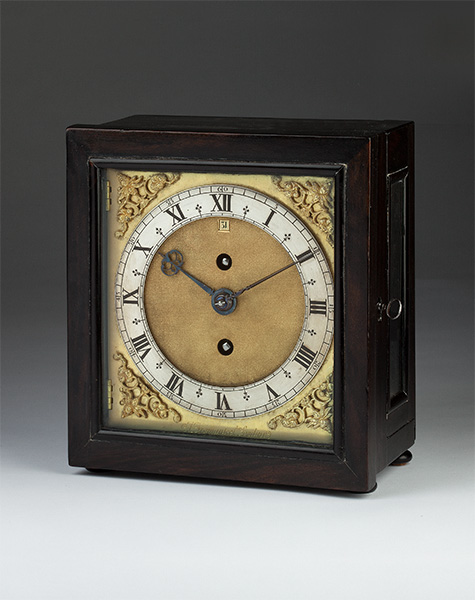
Ahasuerus Fromanteel, Londini 1658/9

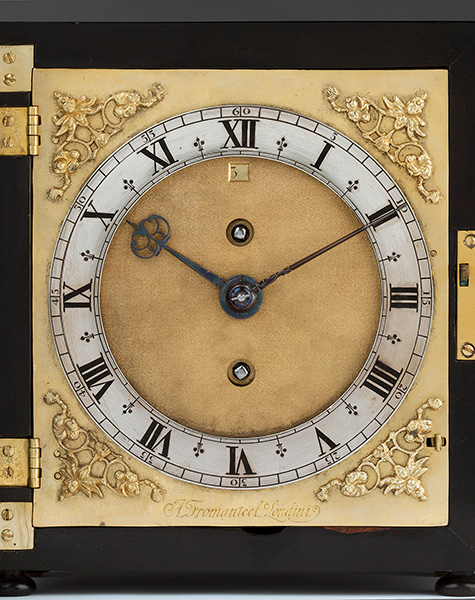
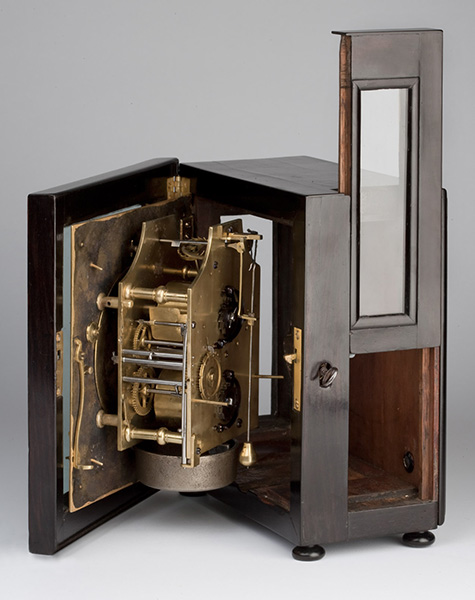
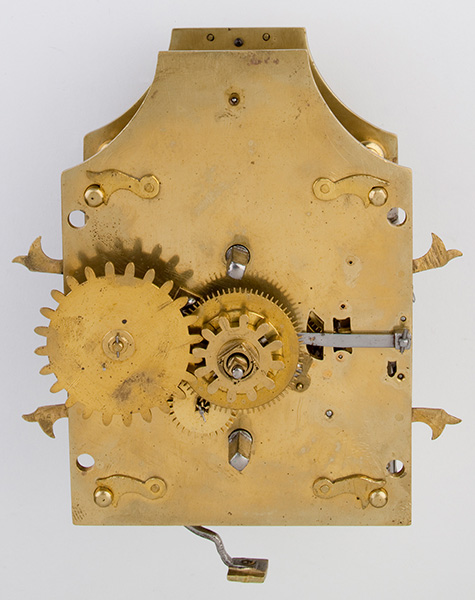
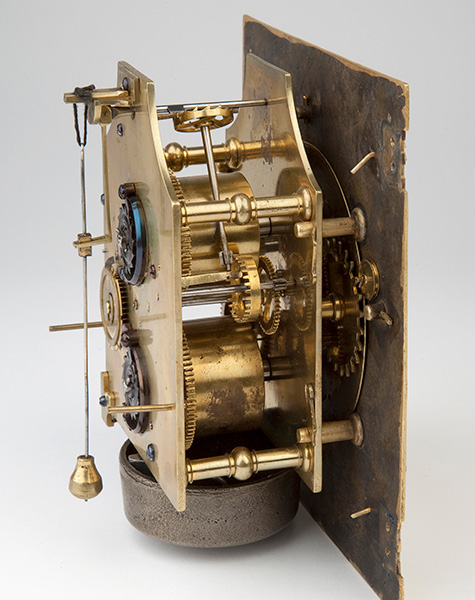
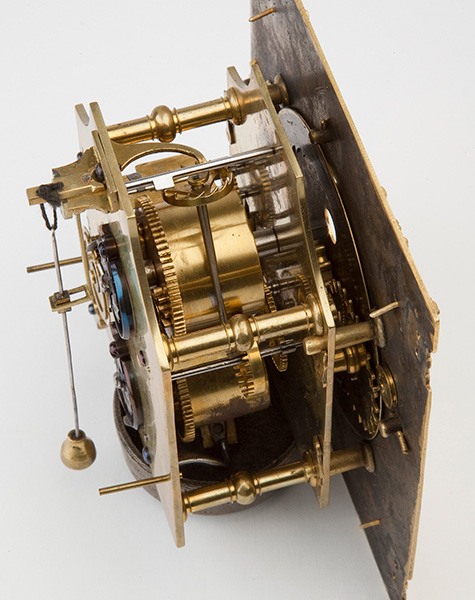
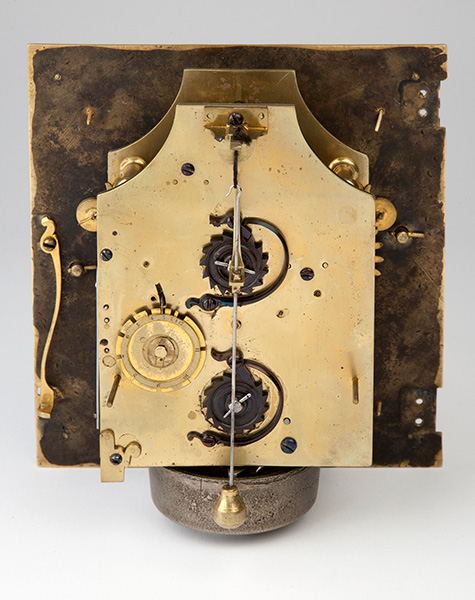
Circa 1658/9
Sold
7 1/2 inches high
Case The case is ebony-veneered and stands 7 3/4 inches high. The front door is quarter veneered with a convex ebony moulding framing the dial. The door lock is on the right side and operates on a simple spring catch. The side windows have delicate convex ebony mouldings; the right side window slides upwards to give access to the striking train. The base is ebony- veneered and raised on four later bun feet. The back is similarly veneered and centred by a rectangular panel. The interior is veneered in the Dutch manner with an unusual hardwood, the bottom has been cut-away to make room for the bell (as it is for the Taylor clock). Dial The dial plate is 53⁄4 inches by 61⁄2 inches; it is fire-gilt and has a matted centre. The spandrels, (missing in the Sotheby’s 1983 sale), are direct copies taken from the Taylor Fromanteel. The narrow silver-faced chapter ring has Roman hour chapters with an outer Arabic minute track, inner concentric quarter divisions and trident half hour markers. The chapter ring is constructed from a silver face soldered to a brass under-ring with 12 solder holes in the brass ring. The delicately modeled blued steel hour hand is original and of unique design; the minute hand is a replacement copied directly from the Taylor Fromanteel. The vertical tandem winding holes are in the centre of the dial with a calendar aperture cut just below chapter XII, the calendar ring itself is engraved brass, gilded and the numerals black wax-filled. The dial is fixed to the movement by four latched dial feet. Movement The movement is suspended from the dial plate, which opens outwards on two hinges. The entire movement - plates, wheels and barrels retain their original gilding. The brass movement plates are rectangular with scooped or curved shoulders, the four pillars are of ringed baluster form and each is latched at the front plate. The wheel train lay-out is unique to this and the Taylor clock with twin vertically positioned going barrels with the original blued steel click wheels and springs mounted on the backplate. The upper barrel serves the going train with the original verge escapement (with minor alterations), the crown wheel and arbor are set at an angle of approximately 70 degrees, the verge is pivoted on the front plate and backcock – the latter being original but modified to accept a silk- suspended pendulum with the original bob. The strike train retains the original pretty countwheel which is mounted on the backplate and applied with a narrow ring calibrated 1-12. The four-wheel strike train has a square-sided bell mounted beneath the movement; it is struck on each hour by a hammer, which pivots in the Dutch manner on a vertically-positioned steel arbor on the inside of the backplate. Provenance • The property of Benjamin Bass Esq. • Sotheby’s, London, 27 October 1983, lot 245. Sold for £46,830; bought by Peter Gwynn for Dr. Herschell H. Boyd, Seattle, WA • Private collection, UK Bibliography • The Gwynn collection of Clocks, Peter Gwynn, vol. 5 of limited edition of 10, signed by the author & presented to Herschell H. Boyd, 1990 • Sotheby’s, London, 27 October 1983, lot 245 • An Early Fromanteel Spring Clock by Percy Dawson, A.H. October 1959 • Early English Clocks by Dawson, Drover & Parkes • Could it have been Wren by Larry Fabian • The first 12 Years of the English Pendulum clock by Michael Hurst (R.A. Lee Exhibition) • Spring driven Table Clocks by Dr. R. Plomp • The Dutch extraction of the Fromanteel Family by Dr. R. Plomp • The Dutch Extraction of the Fromanteel Family by Dr. R. Plomp, A.H. September 1971 • Horological Masterworks, exhibition catalogue, Taylor Exhibition • Huygen’s Legacy, Exhibition catalogue Het Loo • Who invented the Pendulum Clock by Rebecca Pohancenik, Country life article, May 2010 • The Fromanteel Story by Brian Loomes A.H. A.H. vol. 9/2 p. 175 • The Exclusive Fromanteel by E. Aghib, A.H. vol. 6/4 212 • The Fromanteels & the Pendulum Clock by E. Edwardes & R. Dobson A.H. vol. 14/3 p. 250 • Huygens, Coster & Fromanteel, Some Secrets Remain by E. Glasius A.H. vol. 12/4 p. 442 • Some more notes on the Coster-Fromanteel contract by J. Leopold, A.H. vol. 28/5 p. 568 Historical significance This clock is one of the most important timepieces in the field of English horology. It is one of only two extant clocks which are indisputably the earliest-known complete English clocks made with a pendulum escapement. These two clocks were made immediately after Johannes Fromanteel returned from his expedition to Salomon Coster’s workshops in 1658 to learn about the pendulum escapement. That it should bear such close similarity to Coster’s earliest-known pendulum clock is understandably no coincidence. The page opposite demonstrates the likeness of Coster’s earliest-known pendulum clock with that of the present example. Typical of English workmanship, the Fromanteel clock is of significantly more robust construction than Coster’s. However, all the basic thought processes behind this clock’s construction – going barrels, movement ‘hanging’ from the hinged dial, simple box case – are Dutch. The end result is a clock that was constructed almost as if Johannes had to pour his knowledge out onto the workbench before it was all forgotten. For any collector interested in early English clockmaking, this clock is where it all began.
